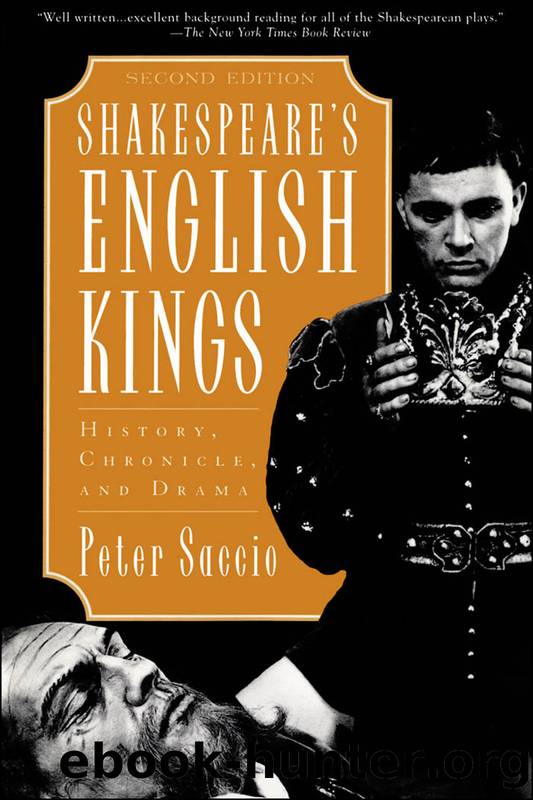Shakespeare's English Kings by Saccio Peter;

Author:Saccio, Peter;
Language: eng
Format: epub
Publisher: Oxford University Press USA - OSO
Published: 1977-05-14T16:00:00+00:00
3. EDWARD IV, 1461-1471
Within three months of the duke of Yorkâs death in December 1460, his eighteen-year-old son, Edward earl of March, became king of England. Once again the house of York made a remarkable recovery from disaster. Edward had not been at Wakefield. Early in December he had gone to collect Yorkist forces in the Welsh marches. There he encountered a Lancastrian army under the leadership of the Welshman Owen Tudor, second husband to Henry Vâs widow Catherine, and Owenâs son Jasper, half-brother to Henry VI. On this, his first independent command, Edward proved himself an aggressive general. By the energy of his attack, he triumphed over the Lancastrians at Mortimerâs Cross, driving Jasper Tudor into flight and executing Owen Tudor after the battle. At Mortimerâs Cross, a peculiar meteorological phenomenon occurred: three distinct suns were seen shining in the heavens before the battle. According to a fifteenth-century chronicle, Edward opportunistically interpreted the triple sun as a token affirming that the Trinity was on his side. This marvel is the only incident Shakespeare uses from the battle of Mortimerâs Cross. In the play, Edward and his brother Richard (whose presence is again unhistorical) take the suns to symbolize eventual triumph for the three sons of York. After this incident, according to both Shakespeare and his source Hall, Edward used the âsun in splendorâ as a personal badge.
Although Mortimerâs Cross showed Edward to be a capable soldier in his own right, the house of York required more than a Welsh victory and an odd atmospheric effect. Margaret and her forces, flush from their triumph at Wakefield, were at large in the north. Securing aid from the Scots, Margaret marched her army south to rescue her husband from Warwick in London. With her were Somerset, Exeter, Young Clifford, and Northumberland. On 17 February 1461, they encountered Warwick and the king at St. Albans, inflicted upon Warwick a heavy defeat, and took possession of the king. But Warwick himself escaped and Margaret was unable to follow up on her victory. Had she marched straight into London after the second battle of St. Albans, the Yorkist cause would have been in ruins. As it happened, however, the Londoners locked their gates against her. On the march south from Wakefield, she had given her army license to sack as they came, thus allowing the single episode of wide-spread devastation, slaughter, and looting that took place during the Wars of the Roses. The Londoners dreaded similar treatment from her marauding northerners. Indeed, the duchess of York, in London at the time, swiftly sent her two younger sons, George and Richard, across the sea to refuge in Burgundy. Margaretâs own miscalculated tactics had stiffened Yorkist sentiment in the south. While she angrily retired north once again, London welcomed Edward and Warwick.
The second battle of St. Albans, however, created a political crisis. Having lost the person of the king, the Yorkist government, which had held sway since the battle of Northampton the previous July, lost all legitimacy.
Download
This site does not store any files on its server. We only index and link to content provided by other sites. Please contact the content providers to delete copyright contents if any and email us, we'll remove relevant links or contents immediately.
| Africa | Americas |
| Arctic & Antarctica | Asia |
| Australia & Oceania | Europe |
| Middle East | Russia |
| United States | World |
| Ancient Civilizations | Military |
| Historical Study & Educational Resources |
Magic and Divination in Early Islam by Emilie Savage-Smith;(1194)
Ambition and Desire: The Dangerous Life of Josephine Bonaparte by Kate Williams(1084)
Operation Vengeance: The Astonishing Aerial Ambush That Changed World War II by Dan Hampton(985)
What Really Happened: The Death of Hitler by Robert J. Hutchinson(868)
London in the Twentieth Century by Jerry White(844)
Time of the Magicians by Wolfram Eilenberger(842)
Twilight of the Gods by Ian W. Toll(811)
The Japanese by Christopher Harding(795)
Papillon by Henry Charrière(793)
Lenin: A Biography by Robert Service(778)
The Devil You Know by Charles M. Blow(777)
Twelve Caesars by Mary Beard(764)
Freemasons for Dummies by Hodapp Christopher;(747)
The Churchill Complex by Ian Buruma(729)
Napolean Hill Collection by Napoleon Hill(701)
The Enlightenment by Ritchie Robertson(690)
Henry III by David Carpenter;(685)
Bohemians, Bootleggers, Flappers, and Swells: The Best of Early Vanity Fair by Bohemians Bootleggers Flappers & Swells- The Best of Early Vanity Fair (epub)(681)
The Rise and Triumph of the Modern Self by Unknown(653)
